Barracuda
Sphyraenidae
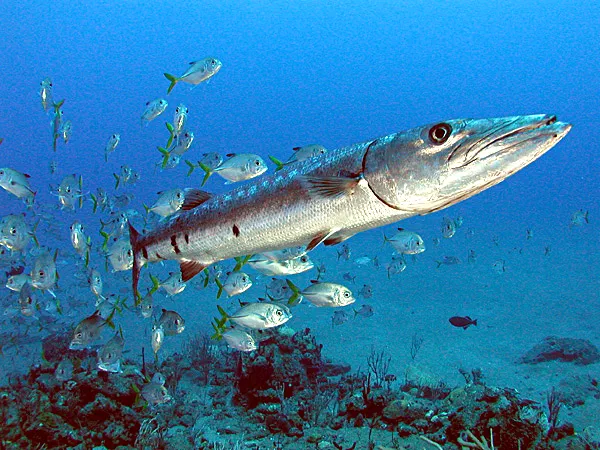
Photo by The original uploader was Aquaimages at English Wikipedia. / CC BY-SA 2.5 via Wikimedia Commons
Few fish inspire the same mix of awe and unease as the barracuda. With their torpedo-shaped bodies, jutting lower jaws packed with razor-sharp teeth, and unblinking stare, they look like nature designed the perfect marine predator - and then cranked up the intimidation factor. Capable of explosive bursts reaching 40 mph, these "wolves of the sea" are ambush hunters that strike with lightning precision. For divers, encountering a solitary great barracuda hovering motionlessly in blue water, watching you with cold curiosity, is an unforgettable experience. But witness hundreds of barracudas swirling in a massive tornado-like school, and you'll see another side of these apex predators - social, synchronized, and absolutely mesmerizing.
🔬Classification
📏Physical Features
🌊Habitat Info
⚠️Safety & Conservation
Identification Guide
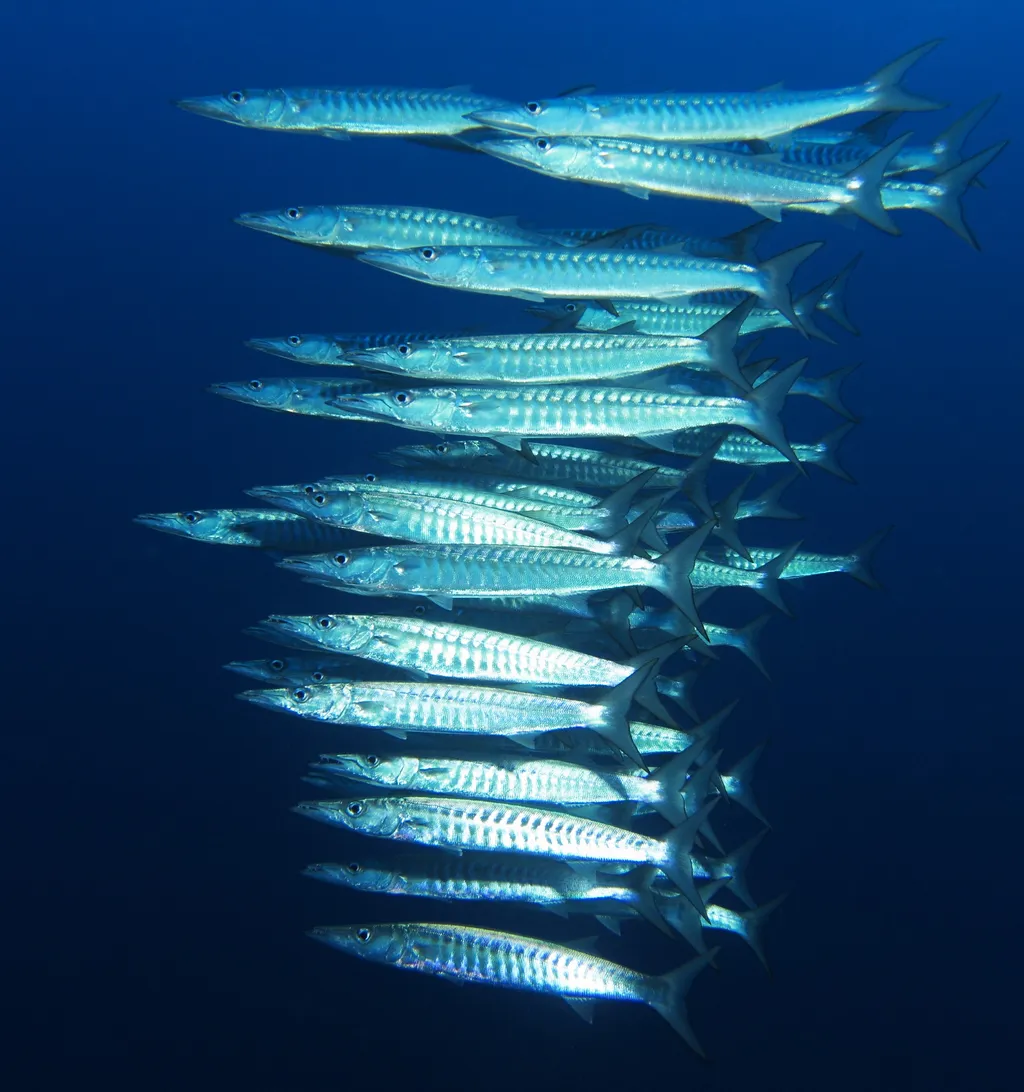
Photo by Alexander Vasenin / CC BY-SA 3.0 via Wikimedia Commons
- Body Shape: Extremely elongated, torpedo-shaped, streamlined for speed
- Jaw: Protruding lower jaw with fang-like teeth visible even when mouth closed
- Eyes: Large, unblinking eyes positioned for excellent forward vision
- Fins: Two well-separated dorsal fins; deeply forked tail fin
- Color Pattern: Silver-gray with darker upper body; some species have vertical dark bars
- Size Variation: From chevron barracuda (45cm) to great barracuda (200cm, 100 lbs)
- Behavior: Often hover motionlessly in mid-water or cruise slowly near reefs
Top 10 Fun Facts about Barracuda

Photo by Rickard Zerpe / CC BY 2.0 via Wikimedia Commons
1. Lightning Strike: From Zero to 40 mph in Seconds
Barracudas are built for explosive acceleration. From a dead stop, they can reach speeds of 35-40 mph (56-64 km/h) in mere seconds, making them among the fastest fish in the ocean. This incredible burst speed is powered by their streamlined, torpedo-shaped body, powerful tail muscles, and specialized muscle fiber composition. Unlike marathon swimmers like tuna, barracudas are pure sprinters - they sacrifice long-distance endurance for devastating short-range attacks. When a barracuda strikes, prey fish have essentially no reaction time. The attack is often over before the victim even knows it's being hunted. This speed comes with a trade-off: barracudas are not particularly maneuverable, which is why they rely on ambush tactics rather than prolonged chases.
2. The Smile That Terrifies: Over 100 Razor-Sharp Teeth
A barracuda's mouth is a nightmare factory equipped with two sets of teeth designed for different lethal purposes. The outer row consists of dozens of small, needle-sharp teeth perfect for piercing and gripping, while the inner row features larger, fang-like daggers that can easily slice through flesh and bone. Large great barracudas can have over 100 teeth, with some reaching 2.5 cm in length. Even more terrifying: some teeth point backward, making it virtually impossible for prey to escape once bitten. The teeth fit into sockets in the jaws (similar to humans), and if one breaks, a replacement grows in. Barracudas employ a "ram-biting" hunting strategy - they charge at high speed and bite prey with such force that they often cut fish cleanly in half in a single strike.
3. The Stare of Death: Visual Predators with Excellent Eyesight
If you've ever been watched by a barracuda, you know the feeling - those large, unblinking eyes seem to bore right through you. Barracudas hunt primarily by sight and have exceptional vision optimized for detecting movement and silver flashes in the water. This visual hunting strategy explains their infamous attraction to shiny objects - jewelry, watches, dive computers, and even camera housings. The flash of light reflecting off these objects mimics the scales of prey fish, triggering an investigative approach (and occasionally, a test bite). This is why experienced divers remove jewelry before diving in barracuda territory. Their forward-facing eye placement provides excellent depth perception for judging strike distance with lethal accuracy.
4. Ciguatera: The Invisible Danger
Barracudas, especially large ones from certain regions, carry a hidden threat: ciguatera toxin. This nerve toxin doesn't come from the barracuda itself but accumulates through the food chain. Toxic dinoflagellates (microscopic algae) living on coral reefs produce ciguatoxins. Small herbivorous fish eat the algae, larger fish eat the small fish, and barracudas eat the larger fish - concentrating the toxin at each level. Ciguatera is colorless, odorless, tasteless, and cannot be destroyed by cooking, freezing, or any preparation method. Symptoms of ciguatera poisoning are bizarre and can last months: gastrointestinal distress, neurological symptoms like numbness and tingling, and the notorious temperature reversal where ice cream burns your mouth and hot coffee feels ice-cold. The toxin concentrates in the liver, gonads, and viscera, making larger, older barracudas more dangerous to consume.
5. Social Paradox: Lone Wolves Who Sometimes School
Adult barracudas are typically solitary, territorial hunters, especially at night when they actively patrol their hunting grounds. But during the day, especially in certain locations, they exhibit remarkable schooling behavior. Juvenile and sub-adult barracudas regularly form schools for protection from larger predators. The truly spectacular phenomenon is the "barracuda tornado" or "barracuda cyclone" - massive aggregations of hundreds or even thousands of barracudas swimming in synchronized, swirling formations. These cylindrical schools can be several meters wide and create a mesmerizing vortex as divers swim through the center. Scientists theorize these aggregations serve multiple purposes: predator confusion (the school looks like one enormous "super-fish"), mating opportunities, and possibly cooperative hunting where they can herd smaller fish into tight balls.
6. Hovering Predators: Masters of Stillness
One of the most unnerving barracuda behaviors for divers is their ability to hover absolutely motionlessly in mid-water, often facing into the current. Using subtle adjustments of their pectoral fins and tail, they maintain position with minimal energy expenditure, essentially becoming living statues. This hovering behavior serves multiple purposes: it's an energy-efficient way to watch for prey, it allows them to blend into the water column (their silver bodies create excellent camouflage), and it positions them for ambush strikes. A barracuda can remain frozen in place for many minutes, then explode into action in a fraction of a second. For divers, being watched by a hovering barracuda creates an eerie feeling - you're being evaluated by a calculating predator deciding whether you're a threat, a curiosity, or (rarely) prey.
7. The Ambush Artist: Patience Over Pursuit
Unlike relentless chasers like tuna or jacks, barracudas are ambush specialists. They rely on stealth, camouflage, and explosive surprise rather than stamina. A typical barracuda hunt involves selecting a strategic position (often near structure or in current channels where fish must pass), hovering motionlessly while blending with the background, tracking prey with their eyes while remaining frozen, and then - STRIKE! The attack lasts less than a second. Their lack of maneuverability means they get one shot, so they wait for the perfect moment when prey is close and unaware. This hunting style is why barracudas are often found near reef edges, channels, and drop-offs where they can ambush fish moving between habitats.
8. Curious, Not Aggressive: The Truth About Attacks
Despite their fearsome appearance and Hollywood reputation, barracudas very rarely attack humans. Documented attacks are extremely uncommon and almost always involve mistaken identity - usually when a diver is wearing shiny jewelry or spearfishing (blood in the water, struggling fish creating vibrations). Barracudas are naturally curious and will often approach divers to investigate, which can be intimidating given their size and teeth, but this behavior is not aggressive - it's reconnaissance. Most barracudas maintain a respectful distance and simply observe. The "danger" is overblown; you're far more likely to be injured by coral or sea urchins than by a barracuda. That said, their curiosity combined with their lightning-fast reflexes means you should never provoke them or create situations that might trigger a defensive or investigative bite.
9. Size Matters: The Great Barracuda Giant
The great barracuda (Sphyraena barracuda) is the apex species of the family, reaching truly impressive sizes. The average adult is 60-100 cm, but trophy specimens exceed 2 meters (6.6 feet) and can weigh over 50 kg (110 pounds). At this size, they have few natural predators - only large sharks, groupers, and occasionally dolphins pose a threat. Great barracudas are capable of taking prey nearly half their own size, attacking reef fish, small tuna, and even immature barracudas. Their lifespan can exceed 14 years, and as they age, they tend to become more solitary and territorial. These giants command respect on the reef and are often the unseen sentinels watching every reef activity from the shadows.
10. Ecosystem Role: Keeping Reef Fish Populations Healthy
As top-level predators, barracudas play a crucial role in maintaining reef health through trophic cascade effects. They primarily target sick, weak, or injured fish, functioning as reef "quality controllers" that remove diseased individuals before they can spread pathogens. By controlling populations of mid-level predators and herbivorous fish, they indirectly influence algae growth on reefs. Barracudas also help maintain prey fish vigilance and behavior patterns - fish schools that evolved under barracuda predation pressure exhibit more coordinated defensive behaviors and better habitat selection. Overfishing barracudas in some regions has led to imbalances in reef ecosystems, demonstrating their importance beyond just being impressive predators.
Diving & Observation Notes
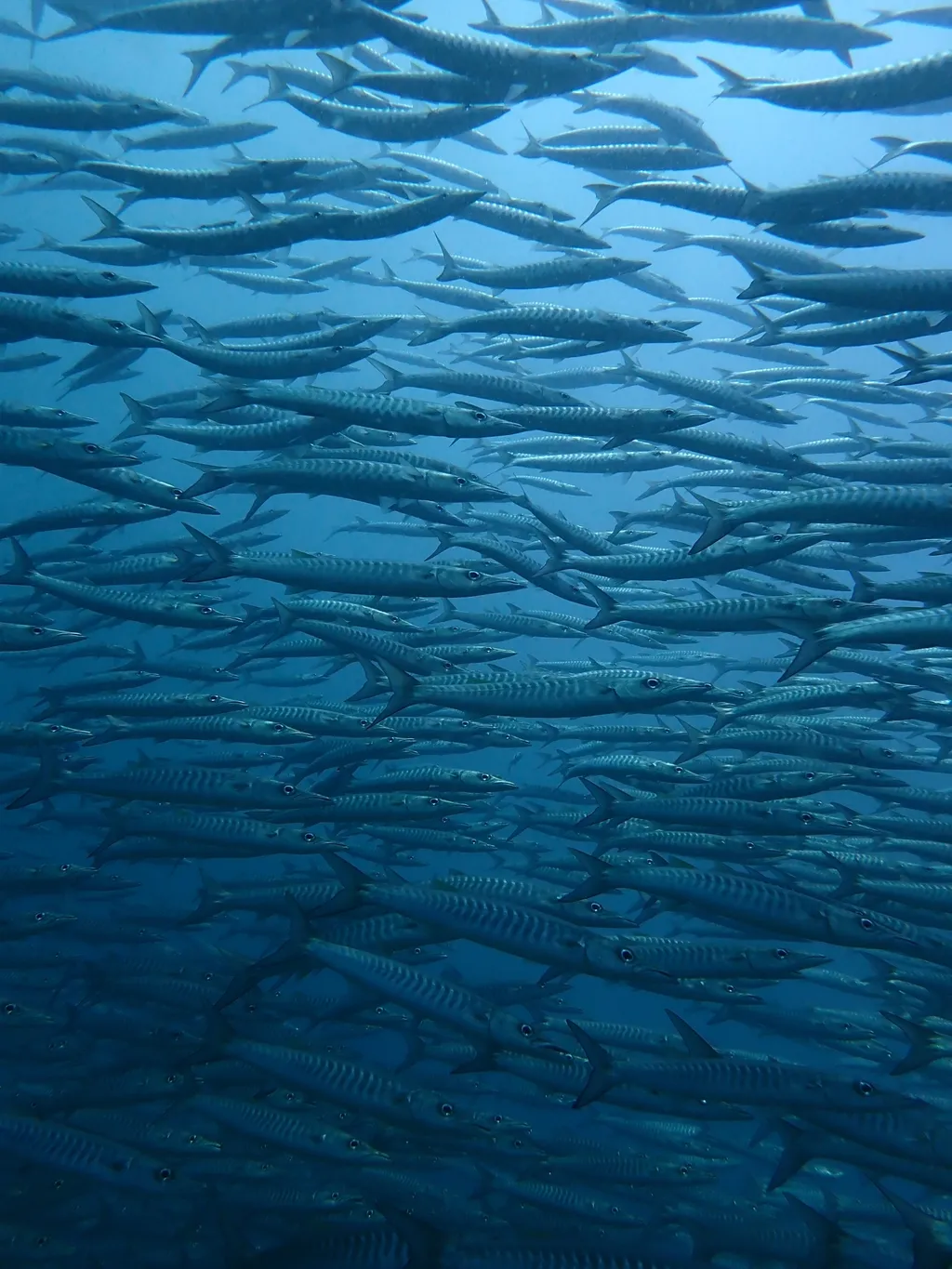
Photo by luluchouette / CC BY 4.0 via Wikimedia Commons
Encountering Solitary Barracudas
Most diver encounters involve a single adult barracuda hovering in blue water or cruising slowly along a reef wall. These encounters are typically harmless but can be unsettling:
- The Stare: Barracudas will often hover and watch you - this is curiosity, not aggression. Continue your dive calmly.
- Following Behavior: Some barracudas follow divers throughout a dive. They're using you as a "hunting partner" - your presence may flush out prey fish.
- Safe Distance: Maintain several meters of distance. Never corner or approach a barracuda aggressively.
- Shiny Objects: Remove jewelry, watches, and shiny accessories before diving in barracuda territory. Even camera ports can attract curious bites.
The Barracuda Tornado: A Bucket List Experience
In specific locations (Sipadan, Red Sea, Palau, Galapagos), divers can witness the spectacular barracuda tornado - hundreds to thousands of barracudas swimming in a coordinated, swirling cylinder:
- Best Time: Usually seasonal - research the specific location's peak schooling period
- Stay Calm: Move slowly and predictably. Sudden movements can cause the school to break formation.
- Enter the Vortex: If the school allows, you can swim into the center of the tornado - an absolutely surreal 360° wall of silver fish.
- Photography: Wide-angle lens essential; shoot upward to capture the school against sunlight filtering through the vortex.
Photography Tips
- Portrait shots: Focus on the eye and teeth - create dramatic close-ups emphasizing their predatory features
- Backlighting: Barracudas silhouetted against blue water or sunbeams create striking images
- Action: Try to capture the moment a barracuda strikes prey (rare but spectacular)
- School formations: For tornado shots, use wide-angle and ensure balanced exposure between the school and blue background
Safety Guidelines
DO:
- Stay calm and avoid sudden movements
- Keep hands close to your body
- Maintain neutral buoyancy to avoid flailing
- Observe respectfully from a distance
DON'T:
- Wear shiny jewelry or watches
- Spearfish in areas with large barracuda populations (they may attack your catch or mistake your shiny spear for prey)
- Corner or chase barracudas
- Feed barracudas (creates dangerous associations)
- Swim in murky water at dawn/dusk in areas with large barracudas (low visibility increases mistaken identity risk)
If a Barracuda Approaches Too Closely
- Stay calm - panic and splashing can trigger investigation
- Face the barracuda - don't turn your back
- Maintain eye contact - they're less likely to approach if they know you're aware of them
- Move slowly backward - avoid sudden movements
- Don't flash cameras repeatedly - the strobe can attract or agitate them
Conservation Awareness
- Barracudas are not endangered but face pressure from overfishing in some regions
- They're important apex predators vital for reef ecosystem balance
- Ciguatera accumulation is increasing in some areas due to climate change and reef degradation
- Never buy barracuda jaw souvenirs - this drives targeted killing
Best Places to Dive with Barracuda

Sipadan & Semporna
Sipadan Island off the coast of Sabah is Malaysia’s crown jewel of diving – a steep limestone pinnacle rising more than 600 metres from the sea floor and teeming with pelagic life. Currents sweep past vertical walls encrusted in hard and soft corals, bringing in barracudas, jacks, reef sharks and bumphead parrotfish in breathtaking numbers. Nearby Mabul and Kapalai offer an entirely different experience on shallow sand‑slope reefs and artificial structures, where flamboyant cuttlefish, frogfish, mandarin fish and other macro critters hide among sponges and tyres. With limited daily permits, a visit to Sipadan is a privilege; most divers base themselves in the frontier town of Semporna or at water‑bungalow resorts on Mabul and Kapalai and make day trips into the park.

Maratua(Derawan)
Maratua Atoll, part of the remote Derawan Archipelago off East Kalimantan, offers thrilling big‑fish dives and rich reefs fed by nutrient‑charged currents. From swirling barracuda tornadoes and reef sharks at the world‑famous Big Fish Country to turtle cleaning stations and macro‑rich jetties, the island’s more than 20 sites deliver everything from ripping drift dives to gentle coral gardens. Expect encounters with green and hawksbill turtles, schooling snapper and jackfish, manta and eagle rays, nurse and reef sharks and even occasional hammerheads. The underwater topography is just as varied—vertical walls, coral pinnacles, sand channels and lush lagoon reefs mean you can pack your logbook with completely different experiences each day. Because Maratua sits far from major tourist hubs, you’ll often have the reef to yourself.
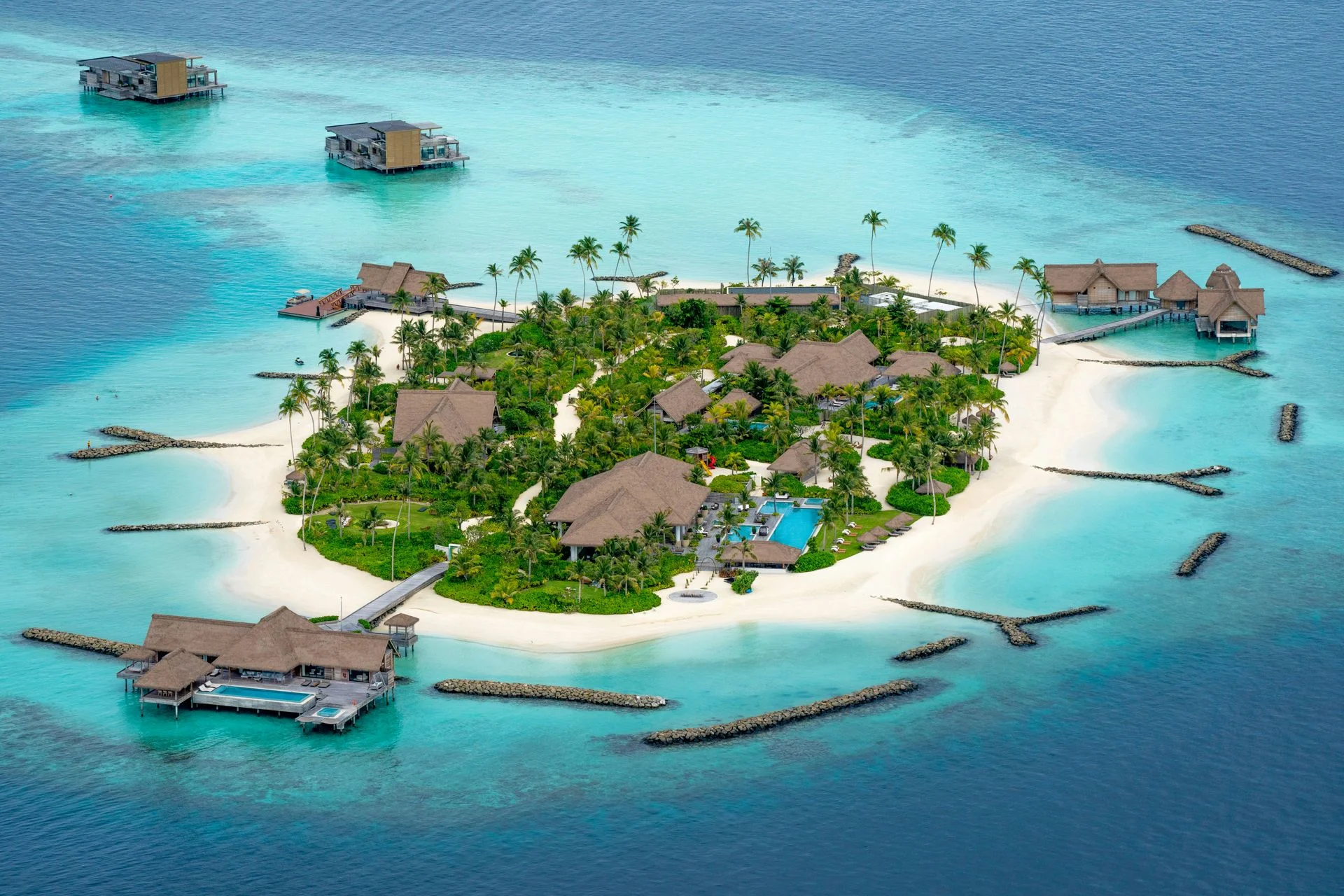
Maldives
Scattered across the Indian Ocean like strings of pearls, the Maldives’ 26 atolls encompass more than a thousand low‑lying islands, reefs and sandbanks. Beneath the turquoise surface are channels (kandus), pinnacles (thilas) and lagoons where powerful ocean currents sweep past colourful coral gardens. This nutrient‑rich flow attracts manta rays, whale sharks, reef sharks, schooling jacks, barracudas and every reef fish imaginable. Liveaboards and resort dive centres explore sites such as Okobe Thila and Kandooma Thila in the central atolls, manta cleaning stations in Baa and Ari, and shark‑filled channels like Fuvahmulah in the deep south. Diving here ranges from tranquil coral slopes to adrenalin‑fuelled drifts through current‑swept passes, making the Maldives a true pelagic playground.
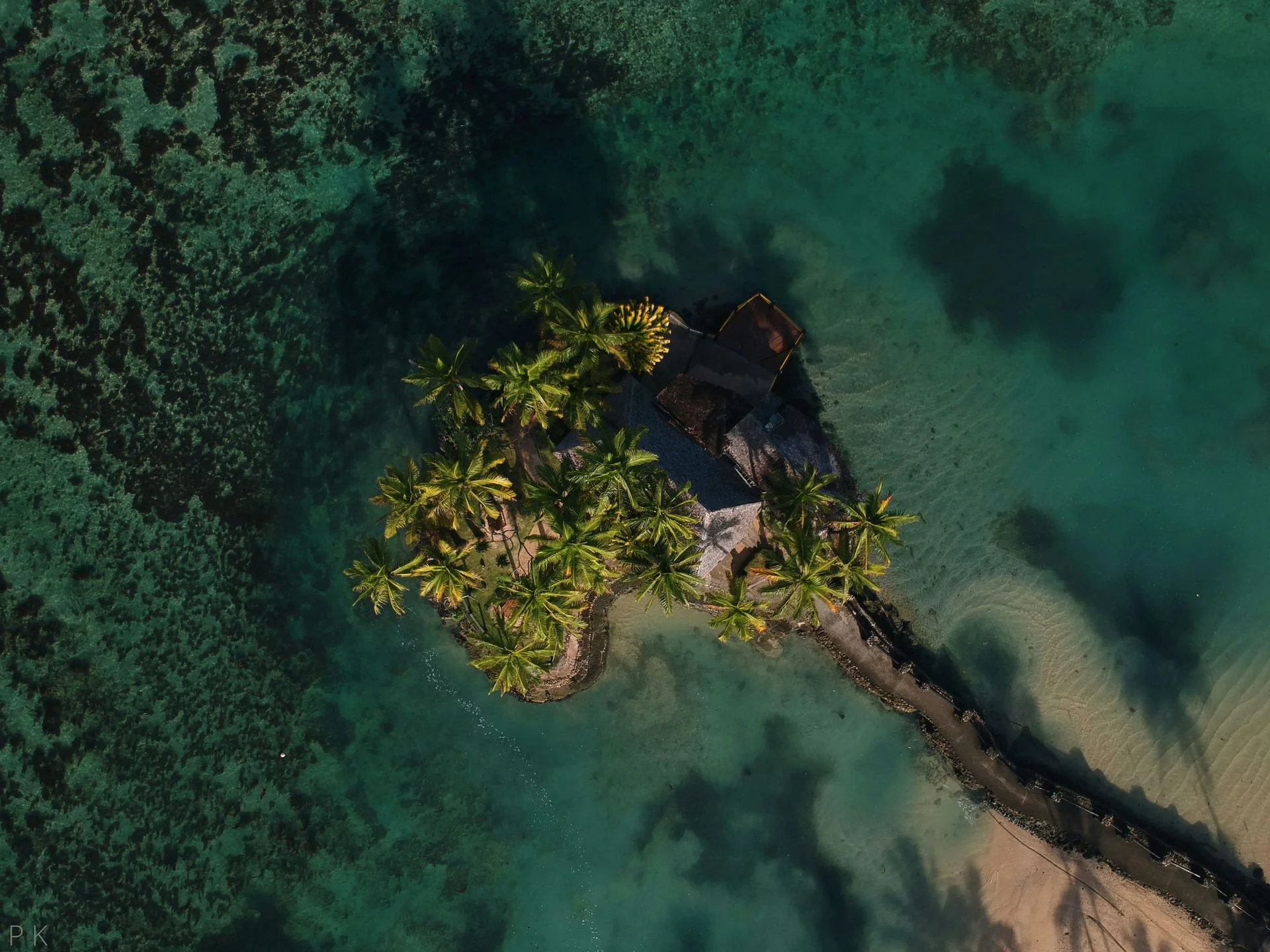
Fiji
Fiji sits like a necklace of more than 300 inhabited islands and 500 smaller islets in the heart of the South Pacific. Jacques Cousteau dubbed it the “soft coral capital of the world” for good reason – nutrient‑rich currents wash over sloping reefs, walls and bommies that erupt in shades of pink, purple, orange and yellow. The country’s dive sites range from kaleidoscopic coral gardens and pinnacles in the Somosomo Strait to shark dives in Beqa Lagoon, and remote passages in Bligh Water and the Koro Sea. Schools of barracuda, trevally and surgeonfish cruise above while manta rays, turtles, bull sharks and occasionally hammerheads glide past. Friendly locals and a relaxed island vibe make Fiji a favourite for both adventurous liveaboard trips and leisurely resort‑based diving.

Palau
Rising out of the western Pacific at the meeting point of two great oceans, Palau is an archipelago of more than 500 jungle‑cloaked islands and limestone rock pinnacles. Its barrier reef and scattered outcrops create caverns, walls, tunnels and channels where nutrient‑rich currents sweep in from the Philippine Sea. These flows feed carpets of hard and soft corals and attract vast schools of jacks, barracudas and snappers, as well as an impressive cast of pelagics. Grey reef and whitetip sharks parade along the legendary Blue Corner; manta rays glide back and forth through German Channel’s cleaning stations; and Ulong Channel offers a thrill‑ride drift over giant clams and lettuce corals. Between dives you can snorkel among non‑stinging jellyfish in Jellyfish Lake or explore WWII ship and plane wrecks covered in colourful sponges.
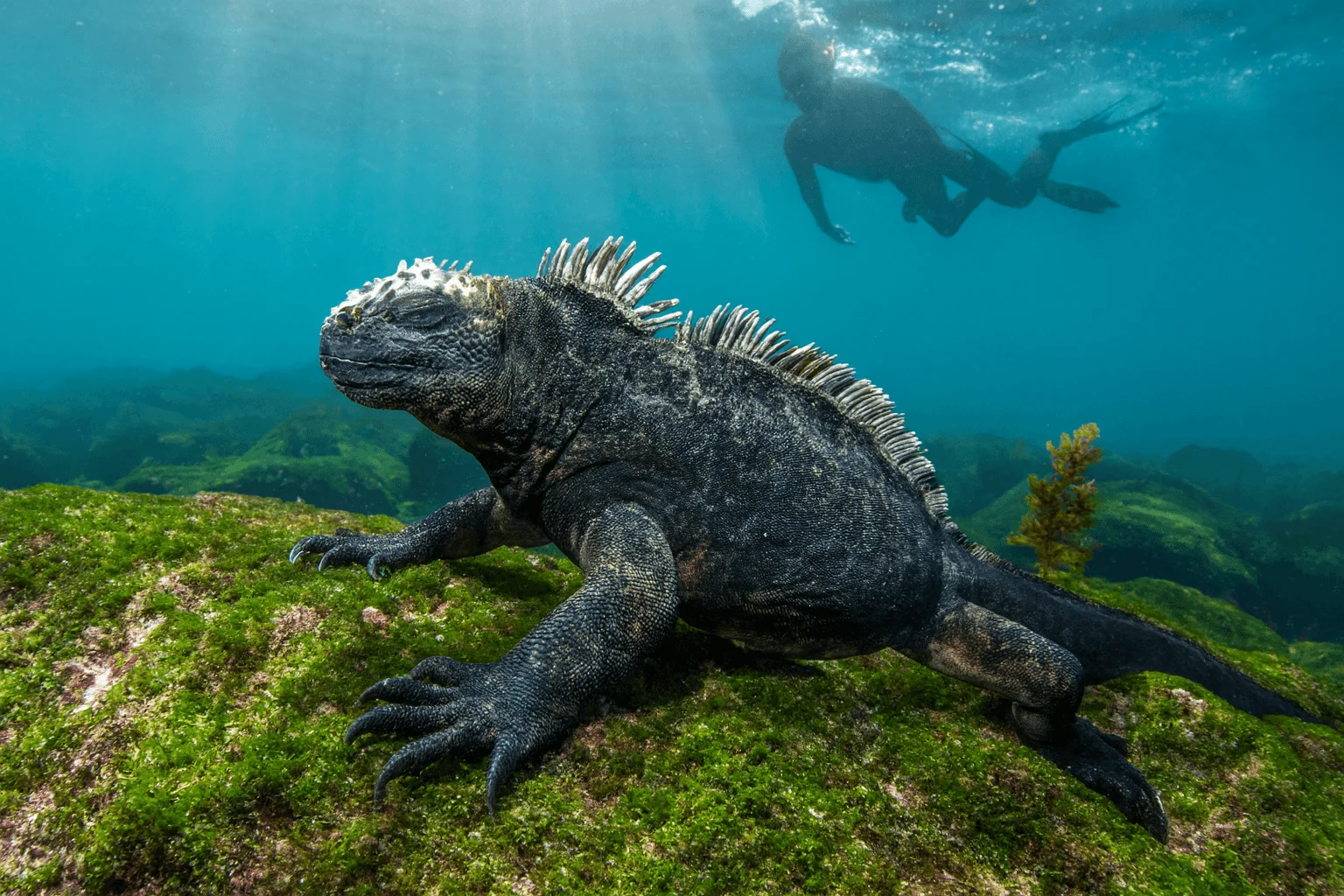
Galapagos
The Galápagos Islands sit 1 000 km off mainland Ecuador and are famous for their remarkable biodiversity both above and below the water. Created by volcanic hot spots and washed by the converging Humboldt, Panama and Cromwell currents, these remote islands offer some of the most exhilarating diving on the planet. Liveaboard trips venture north to Darwin and Wolf islands, where swirling schools of scalloped hammerheads and hundreds of silky and Galápagos sharks patrol the drop‑offs. Other sites host oceanic manta rays, whale sharks, dolphins, marine iguanas, penguins and playful sea lions. Strong currents, cool upwellings and surge mean the dives are challenging but incredibly rewarding. On land you can explore lava fields, giant tortoise sanctuaries and blue‑footed booby colonies.

Komodo
Komodo National Park is a diver’s paradise full of marine diversity: expect healthy coral gardens, reef sharks, giant trevallies, countless schools of fish, and frequent manta ray sightings at sites like Manta Point and Batu Bolong. Drift dives and dramatic reef structures add excitement, while both macro lovers and big-fish fans will find plenty to love. Above water, the wild Komodo dragons roam, giving a touch of prehistoric wonder to the whole trip.
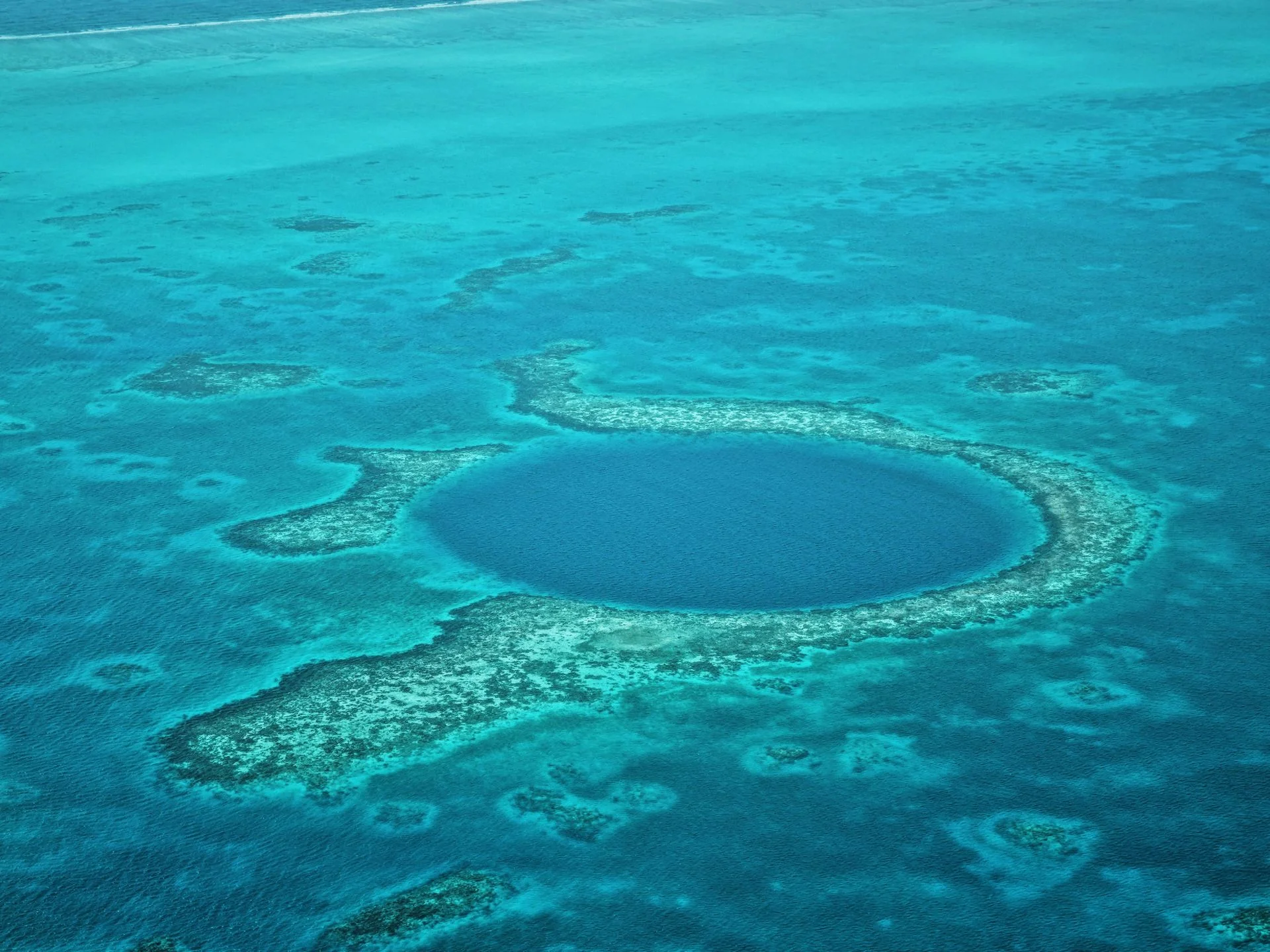
Belize
Straddling the Caribbean and Central America, Belize is home to the world’s second‑largest barrier reef and a string of offshore atolls. Warm, clear water and a relaxed tropical vibe make it a favourite with divers of all levels. The flagship attraction is the Great Blue Hole, a 300‑m‑wide limestone sinkhole plunging to 124 m, but Belize’s real magic lies in its walls and coral gardens. Turneffe Atoll and Lighthouse Reef teem with reef sharks, turtles, eagle rays and massive barrel sponges. Gladden Spit hosts whale sharks from April to June, while Hol Chan Marine Reserve and Shark Ray Alley offer easy snorkelling with nurse sharks and stingrays. Whether you’re a beginner completing your first course or an experienced diver chasing pelagics, Belize delivers with friendly people and laid‑back island life.